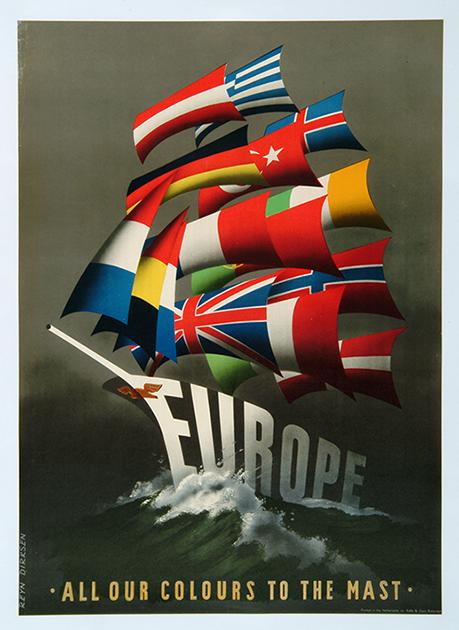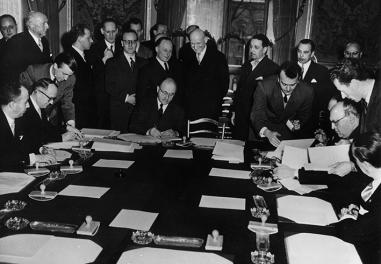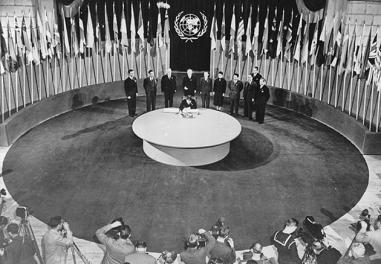April 1948-September 1951: the Marshall Plan
After the victory against Nazism, and to counter Soviet expansion, the United States decided to provide assistance to the European countries. By stimulating growth, the Marshall Plan was to encourage the first steps of European cooperation.

In the aftermath of World War II, a large part of the European continent was devastated: many infrastructures were unusable, the means of production were partially destroyed, supply difficulties and shortages were still common, and many civilians were homeless. In a context of growing tensions with the USSR, the risk of chaos was high and threatened American interests. The economic collapse of the "Old Continent" had to be avoided, investments were needed in industry and agriculture to jumpstart the main business sectors, the populations' needs had to be met and Western Europe had to remain part of the "free world".
The winter of 1946-47 was marked by serious shortages in Europe. The autumn plantings froze, wheat was hoarded. In France, bread rations were reduced from 300 to 250 grams/day. Europe lacked everything: foreign currencies, raw materials, vehicles and machines. France and Great Britain counted on their imperial resources and on financial aid from the new international institutions: the United Nations (UN), the International Monetary Fund (IMF) and the International Bank for Reconstruction and Development (IBRD – World Bank). And yet, imports were halted for several weeks due to the lack of convertible currencies (dollars). Inflation reached 80% in France in 1946. Social unrest gave rise to fears of takeover by the Communist Parties in the Western European countries, which turned to the United States. In 1946, to stabilise the pound sterling, the United States granted Great Britain a substantial loan of 3.5 billion dollars. In May of the same year, the Blum-Byrnes agreements only provided 700 million dollars in new money to the French government. From 1945 to 1947, France nonetheless benefited from 1.9 billion dollars in miscellaneous loans.
A RECOVERY PLAN FOR EUROPE
The cataclysmic atmosphere of the year 1947 led the Truman administration to respond with an economic aid plan, the Marshall Plan (April 1948 / September 1951), preceded by interim aid (December 1947 / April 1948). The Undersecretary of State, Dean Acheson, prepared an aid plan for Great Britain and Greece in March 1947. Within a few days, American decision-makers recognised that democracy was threatened by the USSR and European security was threatened by shortages. Secretary of State George C. Marshall asked the diplomat George Kennan to draw up a recovery plan for Europe.
On 8 May 1947, Dean Acheson proposed American financial aid to the States in need, so they could enjoy peace and prosperity, a kind of prologue to the Marshall Plan. George C. Marshall announced his proposal on 5 June 1947 at Harvard University. Some people hoped this would settle all of Europe's problems, others saw a return to the spirit of Yalta. The Truman administration asked the Europeans to organise themselves collectively. A Franco-Anglo-Soviet meeting was called in Paris at the end of June. It was a failure, as the Soviet Foreign Minister, Vyacheslav Molotov, accused France and Great Britain of wanting to take over all of Europe! The USSR therefore forbade the European States under its control from taking part in the aid plan. In all, sixteen Western European countries asked for 22 billion dollars in aid over four years, 1/4 of which was in the form of loans and 3/4 in donations. They created the Organisation for European Economic Co-operation (OEEC) which was in charge of distributing the aid. In July 1948, the American Congress adopted the amount of credits to be granted – reduced to 17 billion dollars – in a general context of fear of war. The Marshall Plan had two goals: the economic reconstruction of Europe and the defence of a "certain form of civilisation that we share", declared at the time the French Ambassador in Washington. The aid was provided in the form of goods bought and paid for by the American administration, the European Cooperation Administration (ECA). European governments sold them to consumers in the local non-convertible currencies. Funds were accumulated, producing a value equivalent to the aid for use in paying back the States' domestic debts or to finance modernisation and reconstruction by providing relief to the national budgets. The donations from the United States consisted in opening the American market to the Europeans, paying bills in dollars for them and authorising the use of equivalent values by the European States.
Distribution by country was as follows (in billions of today's $):
| 2,826 |
| 2,444 |
| 1,315 |
| 1,297 |
| 0,877 |
| 0,560 |
| 0,546 |
| 0,515 |
| 0,350 * |
| 0,257 |
| 0,236 |
| 0,152 |
| 0,146 |
| 0,118 |
| 0,050 |
| 0,032 |
| 0,029 * |
| 0,023 |
| Total | 11,773 |
* European Payments Union
* Yugoslavia was not part of the Marshall Plan.
In the end, nearly 12 billion dollars in gifts were granted to the Europeans, alongside 1.139 billion dollars in loans, for a total of 13 billion in three years, the actual duration of the programme, an amount equivalent to 130 billion dollars in 2015. The main beneficiaries of the aid were the United Kingdom, France, Italy, the FRG, the Netherlands, etc.
The following graph gives an idea of the products supplied to Europe as part of American aid. Military assistance, provided above and beyond this, was not part of the Marshall Plan aid.
A ZONE OF INFLUENCE FOR THE UNITED STATES
Marshall Plan aid and military aid sped up the Western European's political alignment with the United States, although some countries such as France, Switzerland and Sweden hesitated to accept them. The Marshall Plan contributed to the development of a consumer society and a zone of influence for the United States. The Americanisation of European society was in the spirit of the time. The United States called into question Europe's social and economic models and governance practices. The ECA demanded a moral mobilisation against Communism, neutralism and politicised trade unionism. Winning over public opinion was one of the challenges of the Marshall Plan.
The image of the Europeans that the United States put forward was that of tired, out-of-date peoples. Modernity was American. A consumer society, open to the world, developed its own kind of seduction, illusions and benefits without being imposed by force and the Europeans saw great progress in American consumerism. But they did not abandon their uniquely European values, such as the welfare state. Europe, an old land of political struggles and conquests, continued to adapt its social and economic model to its choices. Fear of the USSR played a coactive role in the American decision to help Europe. The United States needed Europe. Let's give the last word to Robert Marjolin: "The Marshall Plan was less a purely disinterested gesture than a supremely intelligent political act".
Read more
Bibliography :
Les aides américaines économiques et militaires à la France, 1938-1960, Gérard Bossuat, CHEEF, 2001, republished by Kindle, 2013.
Articles of the review
-
The file

After the war, what next for Europe?
Once the guns had fallen silent, people had to learn how to live in peace again. International conferences were organised to establish a new global balance, but by 1947 Europe had been divided into two zones of influence. In the West, a group of politicians motivated by the same ideal nonetheless be...Read more -
The figure

Creation of the UN
Seventy years ago, on 26 June 1945, the United Nations Charter was signed in San Francisco. This founding text of the new international institution joined by 51 countries was designed to ensure world peace and security after World War II.
Read more -
The interview
Mauve Carbonell
Doctor of History, researcher at ESPE Aix-Marseille and member of the teaching team at the Master of European Studies at Aix-Marseille University, Mauve Carbonell talks about the reasons that led to the resurrection of the European idea after World War II.
Read more

